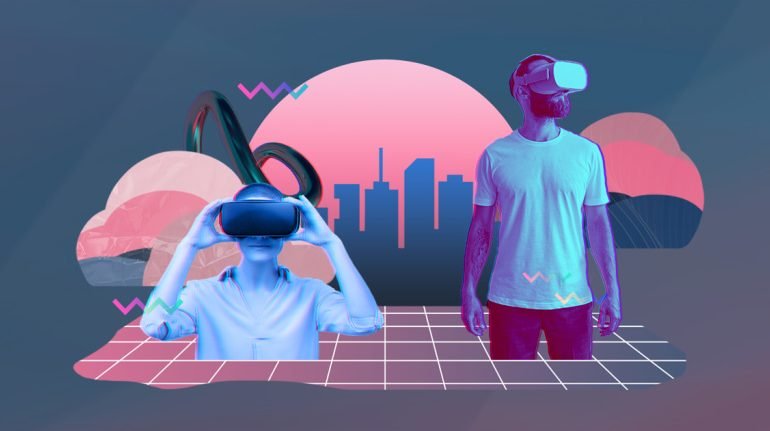5 Amazing Metaverse Examples

5 Amazing Metaverse Examples
Virtual reality (VR) has come a long way since it was first announced to the public in 1968, and now we’re finally seeing VR experiences that seamlessly blend into our actual reality. Metaverse examples are becoming increasingly common, especially as more creators take advantage of platforms like Roblox or Manticore Games’ Core that allows players to seamlessly transition from one virtual world to another as if they were really there. Here are five amazing metaverse examples that you can try out today.
1- Minecraft:

Minecraft is an amazing metaverse example that’s popular with younger generations of gamers. Unlike other games, Minecraft’s developers don’t maintain a heavy narrative: Players simply create their own stories. Using simple tools and in-game resources, players can build custom terrain on virtually any scale including their favorite fictional settings, and play with others online or locally via split-screen. Built by Markus Notch Persson, Sam C418 Schnurr, and Jens Bergensten in 2009 using Java programming language, it has since grown into a wildly successful franchise under Microsoft. (Related: 4 Reasons VR Is The Next Big Thing) Still haven’t had enough? Let’s take a look at Fortnite, Epic Games’ latest hit offering.
2- Roblox

The world’s largest user-generated platform and social gaming network for kids and teens, Roblox has more than 30 million players each month who log in from all over the world to create adventures, play games, roleplay with friends, and learn with millions of community members. Through virtual reality platforms like Oculus Rift or Google Cardboard (recently added), players can immerse themselves in a vast virtual universe that lets them build worlds with their imaginations.
Developers on Roblox can make money by creating experiences on Roblox, earning cash via its Developer Exchange program. Creators also can tap into opportunities to create licensed titles based on hit television shows and films. To date, Roblox has earned nearly $70 million for developers through DEX alone. In March 2016, Roblox launched a new program called Builders Club and announced a multi-year partnership with Microsoft to bring unlimited game access to children using Xbox One consoles starting at age 6. Founded in 2004 and headquartered in San Mateo, CalifRoblox is available on PC, Mac, iOS, and Android devices.
3- Corbine
The combine is a metaverse app with a focus on putting player-created games first. They offer an SDK that lets players build in-game 3D objects, enabling them to create maps from their own ideas and designs. Players have access to 20 million 3D objects and textures, which means they can create detailed virtual worlds easily, and because of Corbine’s emphasis on user-generated content, these worlds feel more personal and interesting as a result. The platform has over 30 million players in its community who play games built on its tech; if you’re planning your own virtual world, Corbine is one metaverse example to consider.
For game devs, a free version allows developers to share creations online with others while profiting from each creation by charging a sale fee when users buy something they created. This is especially attractive for developers selling smaller items like clothing or weapons within their games. There are also enterprise solutions available for larger clients needing large installations or custom solutions.
4- Open Metaverse Project

The Open Metaverse Project, which connects multiple virtual worlds, is a compelling metaverse example. It features avatars of members that can move from one to another in real-time. While these worlds are separate entities and exist as individual servers, they’re still able to interact with each other through chat and customized avatars that sport wearable clothes, accessories, and gear (and anything else built using a 3D engine).
Additionally, member-created content like assets or games can be shared across platforms for any interested user to purchase or access. And because it runs on open software and apps such as JavaScript, WebGL, and HTML5, development becomes even more accessible.
Organizations can use server technology like NodeJS to create their own subdomain to host content from scratch. Other tools like RocketChat for group communication are compatible with multiplayer apps too; add them onto your platform and let users seamlessly connect across them all.
5- Holograms By Holo
Holograms By Holo is a creative platform where users can create, share, and experience holographic content. Holograms have been part of science fiction for a long time and will soon become a natural part of our everyday life. It’s been less than 10 years since we made the shift from 2D to 3D.
From that perspective, we can expect another shift to holograms within our lifetime. Holograms By Holo aims to contribute to making that future now. Right now, it hosts most popular multiplayer games like Fortnite or PlayerUnknown’s Battlegrounds in a real-time multi-user environment via custom avatars.
Gamers are able to socialize while they play and compete with each other in their respective teams. The service also helps users discover new games via featured worlds or hot games lists.
FAQ Most Frequently Ask Question
What is the metaverse in real life?
The metaverse could potentially use virtual reality, or augmented reality as we know it now, to immerse users in an alternate world. The technology is still being developed, but companies like Meta say they are building and improving these devices. Meta’s Oculus Quest, now in its second model, is one such device.
What do you need for the metaverse?
There’s no agreement you’ll need VR or AR to get to the metaverse but they pretty much go hand in hand. That suggests these headsets will be compatible with whatever’s on offer. A new wave of VR and mixed reality headsets are expected this year from Meta, Sony, Apple, and maybe others.





